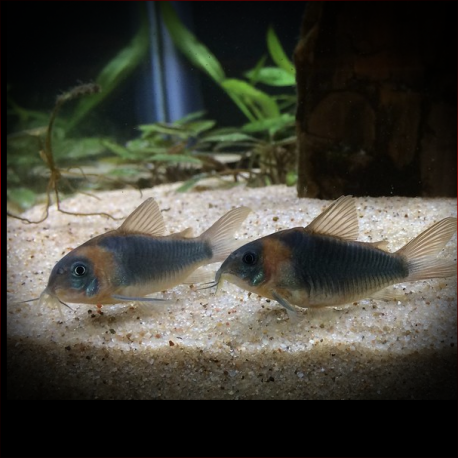More info
Datasheet
| Minimum Tank Size | 80 litres / 21.13 US gallons |
| Maximum Size | 5.0cm / 1.97inches |
| Temperature | 20°C / 68.00°F - 26°C / 78.80°F |
| Hardness | 2.02dgH / 36ppm - 15.02dgH / 268ppm |
| pH | 6.0-8.0 |
General Description
The Corydoras Eques, classified under the Callichthyidae family in the Siluriformes order, was originally placed in the genus Osteogaster by Cope in 1894 but was later synonymized back into the Corydoras genus by Gosline in 1940. These armored catfish are peaceful and gregarious, best maintained in groups of 4-6 individuals. They are omnivores and should be fed a varied diet to ensure optimum health.
Aquarium Setup
For the optimal care of Corydoras Eques, an aquarium setup of at least 80 liters is recommended. It is advised to use fine sand or clean rounded gravel as a substrate. Additional decorations in the tank are a personal preference, but providing cover for security is beneficial. Water conditions should have a hardness of 36-268 ppm, a pH range of 6.0-8.0, and a temperature between 20-26°C.
Behaviour
Corydoras Eques exhibit peaceful and social behavior, thriving when kept in groups of 4-6 individuals. They are facultative air breathers, occasionally surfacing to gulp air. It's essential to handle them with care as the stiffened pectoral-fin spines can cause painful stings due to possible toxic secretions from the axillary glands at their base.
Feeding and Diet
These foraging omnivores accept sinking dried foods, small live, and frozen varieties such as chironomid larvae and Tubifex. Feeding a varied diet is crucial for their well-being, as they should not rely on leftovers or be expected to clean the aquarium.
Reproduction & Dimorphism
Breeding Corydoras Eques requires the provision of floating vegetation for egg deposition near the water surface. A breeding ratio of 2 males per female is recommended. After spawning, eggs can be found on the aquarium glass or in sunken spawning mops, with successful incubation lasting 3-4 days. Females tend to grow larger, with sexually mature individuals being rounder and higher-bodied than males.
Habitat and Distribution
The type locality of Corydoras Eques is the Amazon River at Codajás, Amazonas, Brazil. Although their extended range is unclear, similar fish have been exported from Peru. These catfish are known for their evolution of a highly vascularized intestine for taking up atmospheric oxygen, aiding survival in oxygen-deprived habitats.

